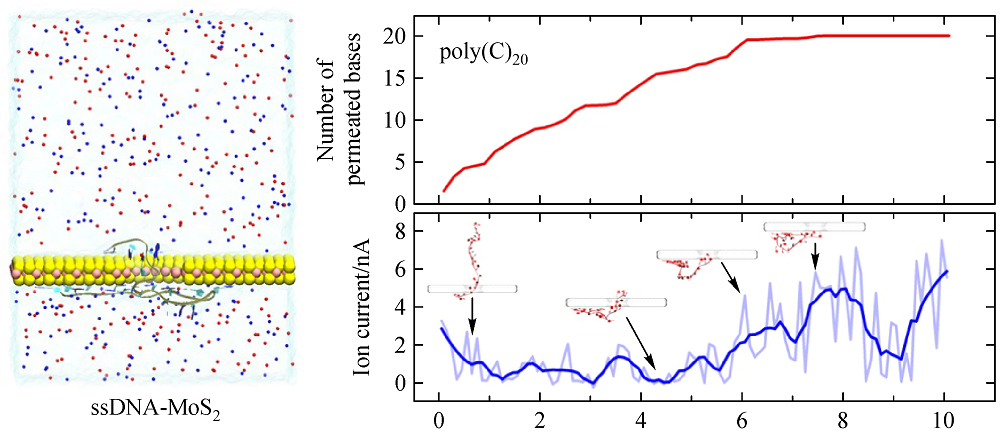Nanopore-based DNA sequencing [
1–
5] provides a new approach for rapid, high-resolution detection of DNA bases (guanine (G), adenine (A), thymine (T) and cytosine (C)). The negatively charged DNA molecules could be driven electrophoretically through a nanopore by an applied external voltage [
6]. Protein nanopores [
7,
8] and solid-state nanopores [
9–
12] have been widely studied for DNA sequencing. However, these pores are limited by low signal-to-noise ratio (SNR) and nonuniform single-base sequencing and are too thick to identify individual bases in the DNA sequence. Furthermore, biological nanopores are prone to disassemble at high biases [
13,
14]. Such drawbacks can be overcome by developing new two-dimensional materials for nanopore sequencing, such as graphene [
15–
18] and MoS
2 [
19–
21], which have attracted extensive attention due to their ultrathin atomic thickness that allows sequencing with single-base resolution. The merits of this type of device are mainly twofold: 1) the film can amplify the baseline and signal amplitude without increasing the noise level, which can greatly improve the SNR; 2) ultra-small and short nanopores can enhance detection accuracy. Graphene, a two-dimensional (2D) nanomaterial, has been studied extensively for DNA sequencing [
22]. The single-atom-thick graphene nanopores allow single-base detection by blocking ionic currents or lateral tunneling currents. However, graphene nanopores have some shortcomings: the lack of band gap for applications such as charged base detection and field effect transistors; strong
p-
p interaction with DNA [
23]; and low detection of SNR. Thus, there is an emergent need to find graphene substitutes or modify graphene to achieve a good sensing performance and a non-adhesive surface, for the development of next-generation DNA sequencing equipment. MoS
2, a 2D single-layer structure analogous to graphene, has found a wide range of applications in sensing, nanoelectronics, and energy storage, among others [
24]. The thickness of single-layer MoS
2 is
~6.5 Å, which is comparable to the spacing between two adjacent bases of ssDNA (3.2–3.5 Å). Previous studies have revealed that MoS
2 has several advantages over graphene with improved SNR [
19,
20] and controllable fabrication of nanopores [
24,
25], suggesting MoS
2 as a promising material for DNA sequencing. Single-layer MoS
2 can be regarded as an “S-Mo-S” sandwich structure, with each Mo coordinating with six S atoms in a trigonal prismatic geometry. Meanwhile, the Mo atom of MoS
2 is hydrophilic, and the S atom is hydrophobic. There are three types of MoS
2 nanopores: Mo atoms only (Mo only), S atoms only (S only), and both Mo and S atoms at the edge of the nanopore (Mixed) [
26]. Thus, the type of atom (Mo, S or both) of the MoS
2 nanopore edge exposed to DNA bases may lead to interactions with DNA that are different from that of graphene. Both experimental and simulation studies have proven that DNA does not adsorb strongly to the MoS
2 surface [
19,
20]. It also has been reported that aromatic compounds (e.g., pyridine and purine) or conjugated compounds could physically adsorb to MoS
2 surface [
27].















